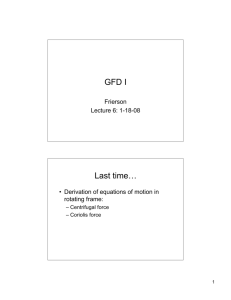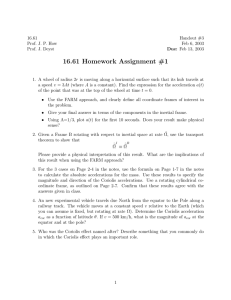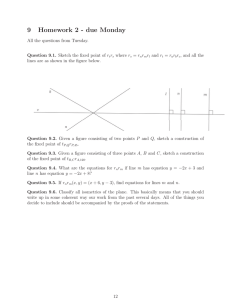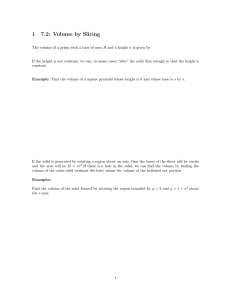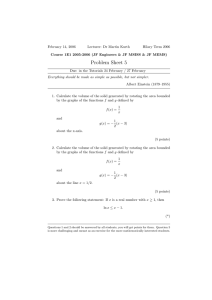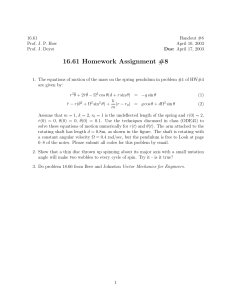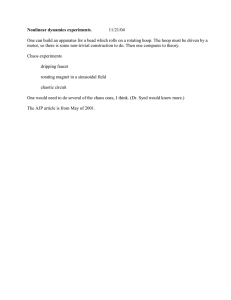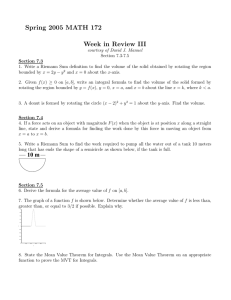Lecture 14 14.1 Administation 14.2
advertisement
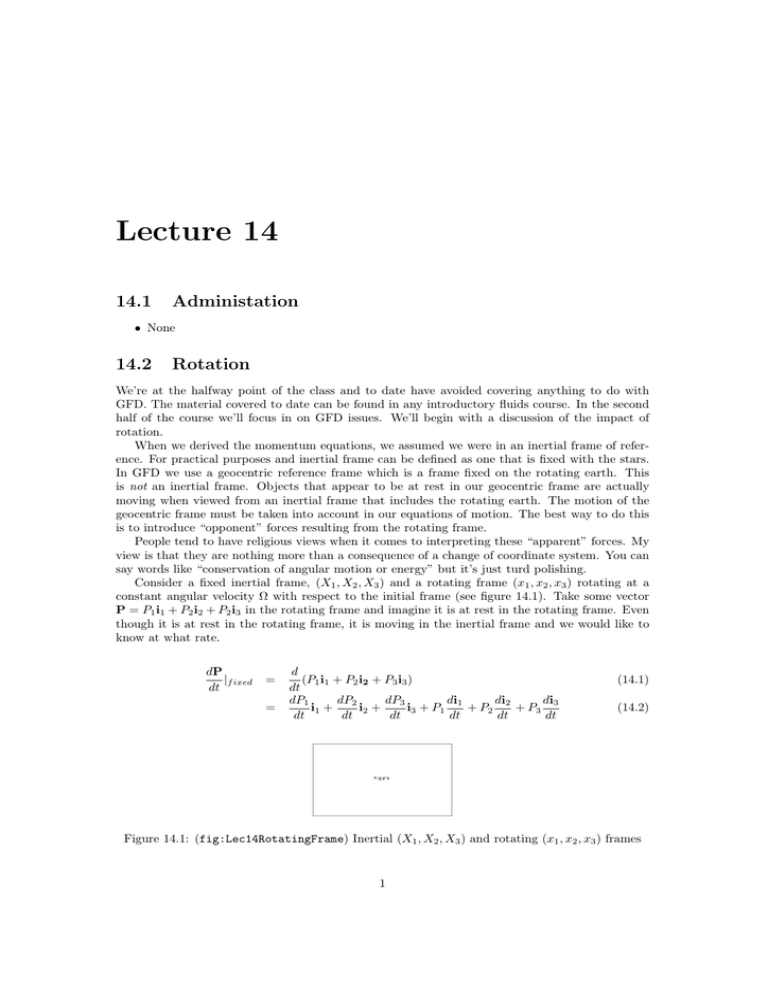
Lecture 14 14.1 Administation • None 14.2 Rotation We’re at the halfway point of the class and to date have avoided covering anything to do with GFD. The material covered to date can be found in any introductory fluids course. In the second half of the course we’ll focus in on GFD issues. We’ll begin with a discussion of the impact of rotation. When we derived the momentum equations, we assumed we were in an inertial frame of reference. For practical purposes and inertial frame can be defined as one that is fixed with the stars. In GFD we use a geocentric reference frame which is a frame fixed on the rotating earth. This is not an inertial frame. Objects that appear to be at rest in our geocentric frame are actually moving when viewed from an inertial frame that includes the rotating earth. The motion of the geocentric frame must be taken into account in our equations of motion. The best way to do this is to introduce “opponent” forces resulting from the rotating frame. People tend to have religious views when it comes to interpreting these “apparent” forces. My view is that they are nothing more than a consequence of a change of coordinate system. You can say words like “conservation of angular motion or energy” but it’s just turd polishing. Consider a fixed inertial frame, (X1 , X2 , X3 ) and a rotating frame (x1 , x2 , x3 ) rotating at a constant angular velocity Ω with respect to the initial frame (see figure 14.1). Take some vector P = P1 i1 + P2 i2 + P2 i3 in the rotating frame and imagine it is at rest in the rotating frame. Even though it is at rest in the rotating frame, it is moving in the inertial frame and we would like to know at what rate. dP |f ixed dt = = d (P1 i1 + P2 i2 + P3 i3 ) dt di1 di2 di3 dP1 dP2 dP3 i1 + i2 + i3 + P1 + P2 + P3 dt dt dt dt dt dt (14.1) (14.2) Figure 14.1: (fig:Lec14RotatingFrame) Inertial (X1 , X2 , X3 ) and rotating (x1 , x2 , x3 ) frames 1 Figure 14.2: (fig:Lec14MovingUnitVector) In the rotating frame the unit vector is moving. The tip of, say, i, will trace out a circle around the Ω axis. The radius of the circle is |i| sin α where α is the angle between i and Ω. Thei vector change is given by the length of the arc of the circle traveled in dt. dP |f ixed dt = di1 di2 di3 dP |rot + P1 + P2 + P3 dt dt dt dt (14.3) In this example, the rate of change in the rotating frame is zero, but there is still a rate of change in the fixed frame due to the motion of the rotating frame’s axes. We can quantify this (see figure 14.2). The tip of, say, i, will trace out a circle around the Ω axis. The radius of the circle is |i| sin α where α is the angle between i and Ω. The i vector change is given by the length of the arc of the circle traveled in dt. ⇒ |di1 | = |i1 | sin α dθ The rate of change is then di1 dθ dt = |i1 | sin α dt Here α and |i1 | are constant. But since dθ dt = |Ω|: di1 dt = |i1 | sin α|Ω| (14.4) (14.5) (14.6) The direction of the rate of change is perpendicular to both i1 and Ω. We have a magnitude |Ω||i1 | sin α and a direction perpendicular to both Ω and i1 (check with RHR), ⇒ di1 = Ω × i1 dt (14.7) This is true for any i (any α), so dP |f ixed dt = = dP |rot + P1 Ω × i1 + P2 Ω × i2 + P3 Ω × i3 dt dP |rot + Ω × P dt (14.8) (14.9) When the particle is at rest in the rotating frame, there is motion in the fixed frame, given by Ω × P. This relationship gives us a rule that can be applied to any vector. Take P = r, the position vector, then: dr |f ixed dt uf ixed dr |rot + Ω × r dt = urot + Ω × r = (14.10) (14.11) u is a vector, so we can apply our transformation rule: duf ixed |f ixed dt = duf ixed |rot + Ω × uf ixed dt 2 (14.12) Figure 14.3: (fig:Lec14rR) Ω × r = Ω × R Substitute: duf ixed |f ixed dt durot duf ixed |f ixed = |rot dt dt af ixed d (urot + Ω × r)|rot + Ω × (urot + Ω × r) dt dr |rot + Ω × urot + Ω × (Ω × r) + Ω× dt = arot + 2Ω × urot + Ω × (Ω × r) = (14.13) (14.14) (14.15) Here, along the way, we have made use of Ω = constant and dr dt |rot = urot . It is useful to rewrite the final term with r = R. This is alright since Ω × r = Ω × R. Have same direction and |Ω| |r| sin α = |Ω| |R|! (see figure 14.3). So Ω × (Ω × R) (14.16) using A × (B × C) = (A · C)B − (A · B)C Ω × (Ω × R) = (Ω · R)Ω − (Ω · Ω)R (14.17) (14.18) = −Ω2 R (14.19) Here we have made use of the fact that Ω · R = 0 because they are perpendicular. Substitution yields: af = ar + 2Ω × ur − Ω2 R (14.20) Here the LHS is the acceleration in the fixed frame, the 1st term in the RHS the acceleration in the rotating from, the 2nd term is the Coriolis effect, and the 3rd term the centrifugal effects. 14.3 Equations of motion in a rotating frame What we derived the first half of class was an af . What we want is ar ... the equations of motion in the rotating frame. a = af − 2Ω × u + Ω2 R Du Du − 2Ω × u + Ω2 R = Dt Dt f Du ν 1 = g − ∇p + ν∇2 u + ∇(∇ · u) − 2Ω × u + Ω2 R Dt ρ 3 1 ν Du 2 = (g + Ω R) − ∇p − 2Ω × u + ν∇2 u + ∇(∇ · u) Dt ρ 3 Notice that I’ve lumped g and Ω2 R together... more on that later. 3 (14.21) (14.22) (14.23) (14.24) Figure 14.4: (fig:Lec14GravityCentrifugal) Centrifugal force acting to make the bulge at the equator. Figure 14.5: (fig:Lec14EqualPotentialSurface) The net is perpendicular to the surface. 14.4 Centrifugal force Let’s talk a bit about that centrifugal force: Ω2 R. It depends only on the rotation rate |Ω| and the distance from the axis of rotation, R. The impact of the centrifugal force is to try and pull apart a rotating body. At planetary scales gravity counteracts this tendency to fly apart, but the centrifugal force does have an impact. (Q1) In the absence of rotation our earth would be a sphere, but because of rotation the centrifugal force distorts the sphere making it bulge as you got close to the equator (where the force is largest) (see figure 14.4). Why don’t we roll towards the equator? The impact of the centrifugal force is to distort the surface of the earth to such a degree that the components of the gravitational and centrifugal forces tangent to the surface exactly balance. Said a different way, the sum of the gravitational and centrifugal forces end up being normal to the surface. Jim’s note to self: Draw Pix The deformation of the surface of the water in a rotating tank is analogous to the deformation of the earth (see figure 14.5). This business about the resultant force being perpendicular to the surface suggests we can sweep the impact of the centrifugal force into our gravity term. Recall: Du Dt ν 1 = − ∇p + ν∇2 u + ∇(∇ · u) + (g + Ω2 R) − 2Ω × u ρ 3 (14.25) Notice I’ve lumped g and Ω2 R together. From here on out our definition of gr will be g + Ω2 R but we’ll leave off the r subscript. This might worry you a bit if you recall back to, say, Bernoulli where we expressed g as a potential. Can we still do this with our new g? Yes! The trivial proof is to define the z direction to be normal to the surface instead of as towards the center of the earth so gk = ∇gz. So now we have: Du Dt ν 1 = − ∇p + ν∇2 u + ∇(∇ · u) + g − 2Ω × u ρ 3 Where g = g + Ω2 R. 4 (14.26) Figure 14.6: (fig:Lec14CoriolisForce) −2Ω×u: Ω is out of the earth in the northern hemisphere so −2Ω × u is a force acting to the right of u (Q2). Figure 14.7: (fig:Lec14Projectile) Projectile motion. (Jim – This picture should probably be omitted). 14.5 Coriolis force That sorts out the centrifugal force leaving us everyone’s favorite, the Coriolis force (see figure 14.6). The classic Coriolis example is to imagine you are sitting on the North Pole and just happen to have a Howizter handy. You fire the thing off and because the Earth is turning under the projectile to you the shell is turning to the right. From the point of view of an observer in an inertial frame, the projectile follows a straight path. The angular deflection of the projectile must be Ωt, the earth’s rotation in time t. Note that because the Coriolis force acts at right angles to the velocity, it does no work w = F · u = 0. (Jim’s note to self – Show projectile movie). See figure 14.7. All that is happening in the projectile case is that the Earth is turning beneath the projectile... all we are seeing is the impact of the Coriolis force. Of course this explanation of rotating out from under doesn’t hold if shot North from the equator. 14.6 Demonstration Before I can do any demos, I need to spend a little time discussing the set up. Obviously, this turntable doesn’t look much like a sphere, but noticed the curved surface. It was created by firing up a turntable and filling a form with resin. The free surface of the resin deformed due to the centrifugal force until it reached a state where the centrifugal force was balanced by the pressure gradient (see figure 14.8). One of the implications of the shape of the surface is that if you put a particle on the surface and gave it a velocity equal to the angular velocity of the rotating frame the centrifugal force tangent to the surface is balanced by the gravitational force tangent to the surface (see figure 14.9). Show AVI files of particle stationary in the rotating frame. Point of view of rotating, then inertial. 5 Figure 14.8: (fig:Lec14SurfaceHeight) z = Ω2 r 2 2g Figure 14.9: (fig:Lec14ForceBalance) Resultant of gravitational and centrifugal forces is perpendicular to the surface. Perform demonstration That was the case where the particle is stationary in the rotating frame. What about when the particle is stationary in the fixed frame? If we have a frictionless particle, then the only force acting on the particle in the fixed frame is gravity (see figure 14.10). This will cause the particle to slide down the surface of the parabola and back up the other side. Then back again. The particle will oscillate back and forth in the fixed frame. What the heck does this oscillation look like in the rotating frame? (Q3). AVI × 6 (2 standard, 2 v0 , and 2 Ω0 ) Demo What’s up with those circles in the rotating frame? In the rotating frame there is a balance between the Coriolis force and the centrifugal. We’ll talk much more about balances in a lecture or two, but in brief we the equation of motion in the r-direction: r: Dur 1 ∂p =− + 2 Ωuθ = 2 Ωuθ Dt ρ ∂r (14.27) Expand: u2 ∂ur + u · ∇ur − θ ∂t r = +2 Ωuθ (14.28) Figure 14.10: (fig:Lec14GravityFixedFrame) In the fixed frame, gravity is the only force that is acting on the particle. 6 Figure 14.11: (fig:Lec14EllipticalTrajectory) With a bit of initial ur and a bit of uθ , there is an elliptical trajectory. The motion we observe has a fixed r, so dur dt and u · ∇ur = 0. We are left with −u2θ r = (14.29) +2Ωuθ This is a balance between centrifugal and coriolis forces. −uθ = 2Ωr ⇒ r= −uθ 2Ω (14.30) For r > 0, uθ < 0, so just as we observe in the movies and on the table, we get circular motion in a clockwise, or anti-cyclonic, direction. The period of oscillation of these circles is given by: P = 2πr 2πr π = = |uθ | 2Ωr Ω (14.31) Note that the period of the turntable (or earth) is: Pt t = 2π Ω (14.32) The period of the circles is one half the period of the turntable (or Earth). These are called inertial circles or inertial oscillations. We don’t really see them in the atmosphere (too many pressure gradients) but you do see them in the ocean. Everything I’ve shown you so far has been limited to either pure ur or pure uθ velocities in the fixed frame. In the fixed frame, if I give my particle a bit of ur and a bit of uθ , I end up with an elliptical trajectory (see figure 14.11). AVI × 2 DEMO Hopefully these videos and demos have given you a feel for the coriolis force. We will quantify these things in later lectures. 14.7 Reading for class 15 KC01: 5.6 (vorticity in rotating frame), 14.1 - 14.4 (GFD, f and β plane) CR94: 3.1 (equations), 3.4-3.5 (GFD), 4.1 (geostrophy), 14.5 (geostrophic flow) 7
